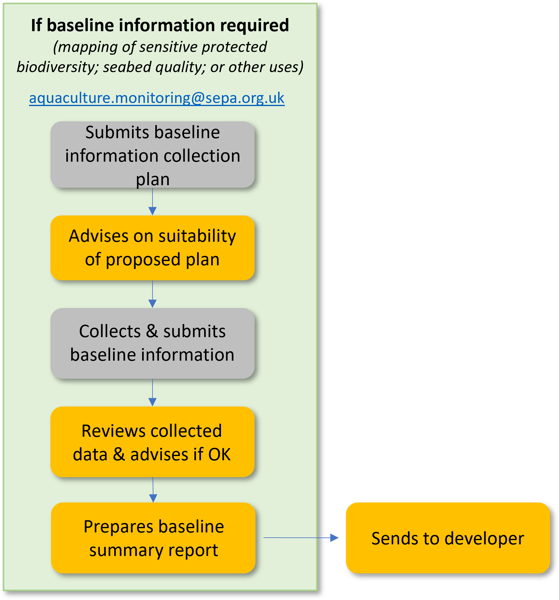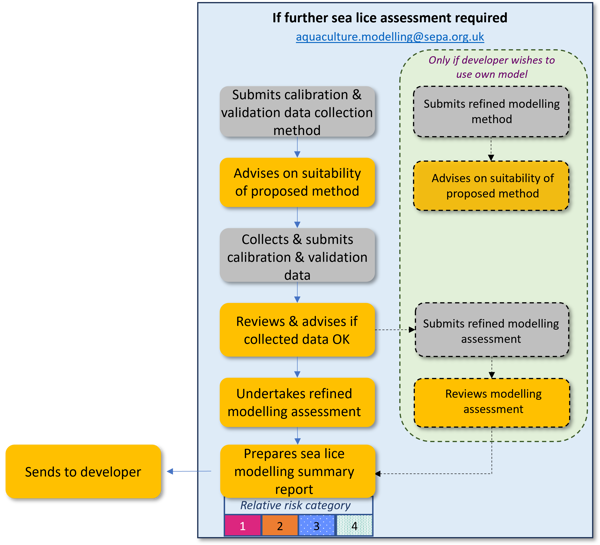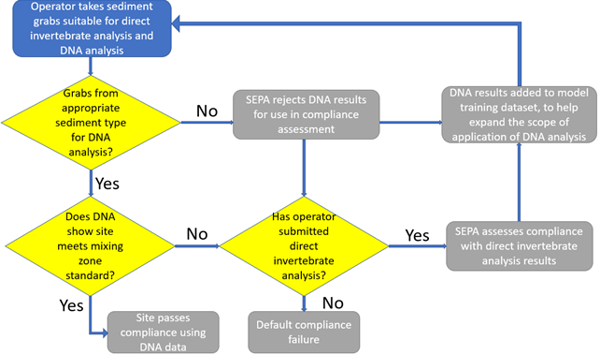Pre-application discussions
Making a marine pen fish farm application for a SEPA permit requires a substantial amount of supporting information.
In simple terms the following information needs to be collected:
- an understanding of how the proposal may impact on local communities. At pre-application stage, you should get this by engaging with the communities that may be affected
- bathymetry and current data to understand how material will be dispersed from the farm
- computer modelling to understand how marine species or habitats could be affected and
- surveys to understand the current state of the environment and confirm the presence or extent of important species or habitats
The work to collect the information has to be done in the right order and to the right standards. Making a mistake at the start of the process could compromise all the subsequent work. Consequently, we recommend that applicants follow the structured approach to collecting information illustrated in the flow charts below. SEPA can then review the information collected at each stage to ensure that it is fit for purpose to allow you to move on to the next stage.
Flow 1 - Marine pen fish farm pre-application process
View Accessible flowchart for Marine pen fish farm pre-application process

Flow 1.1 - assessment of organic solid, medicine or nutrient discharges required

Marine pen fish farm process assessment of organic solid, medicine or nutrient discharges
Flow 1.2 - baseline information required

Flow 1.3 - Further sea lice assessment required

Contact details
A SEPA lead officer will be identified for each pre-application discussion and their contact details will be provided.
The following menu provides access to the SEPA pre-application process and the associated guidance documents that will support you submitting an application.
Purpose
To record the start of the pre-application process and capture information required for Screening Modelling and Risk Identification.
Process
- The applicant emails completed pre-application proposal form and any additional information to SEPA using aquaculture.pre-app@sepa.org.uk
- SEPA Registry enters details into the licence management system and creates a reference number
- SEPA Registry sets up a pre-application file structure and store the information (access to these folders is controlled)
- SEPA Registry emails the applicant to acknowledge receipt of the proposal and to confirm that the information has been passed to the lead co-ordinating officer
- SEPA Registry passes the information on to the lead co-ordinating officer
- The SEPA lead co-ordinating officer passes the information on to SEPA modelling
Supporting information
Purpose
For SEPA to carry out an initial assessment of the proposal to determine what further assessment work needs to be carried out. This includes screening modelling by SEPA Modelling.
Process
- SEPA Modelling carries out the screening modelling and produce a draft screening report
- SEPA Modelling discuss the proposal and screening model output with wider range of SEPA colleagues, as appropriate. Risks are identified by this group and these are added to the draft screening report to form the Screening Modelling and Risk Identification report
- SEPA Modelling sends the draft Screening Modelling and Risk Identification report to the SEPA lead officer (Permitting Officer), who sets up an internal screening case review meeting to agree the response to the applicant. The SEPA lead officer chairs the meeting and records the outcome. If necessary the screening report is updated
- The SEPA lead officer writes to the applicant enclosing the Screening Modelling and Risk Identification report
- The applicant is given 21 days to review and comment on the screening report. SEPA will review any comments that the applicant makes and may update the screening report if deemed appropriate.
- SEPA publish the screening report on the website following the 21 day review period. It will remain on the website for 1 year, or until the application is determined (whichever is sooner).
- The Screening Modelling and Risk Identification report informs the engagement meeting(s) and is updated and re-published to reflect any new information received from that meeting.
Timescale
Screening Modelling and Risk Identification report to be provided to the applicant within six weeks of the receipt of a pre-application proposal.
We have provided an example of this report in order to show the type of information we intend to produce during the screening modelling and risk identification stage of the pre-application process. The example was generated using a fictional site proposal.
Supporting information
Purpose
To engage local communities early in the pre-application process and identify sensitive receptors that could be affected by the proposal. The expectation is that this engagement would happen at the same time as any engagement required for planning so that all parties can reach a common understanding of the issues that need to be assessed.
Process
- The engagement meeting will be informed by the SEPA Screening Modelling and Risk Identification report
- The applicant should discuss with the SEPA lead officer how these meetings will be organised and who should be invited. This is to make sure that SEPA's interests are covered
- The applicant organises the meeting(s) and makes available details of the proposal and the Screening Modelling and Risk Identification report
- The operator should record issues relevant to the permit pre-application assessment process and information about any priority marine features that might be affected by the proposal or interests of other water users that might be affected by the proposal
- Where relevant issues are identified, the SEPA lead officer organises an engagement case review
Engagement case review
Purpose
To review and update the Screening Modelling and Risk Identification report in light of the information received from the engagement process.
Process
- The SEPA lead officer organises the engagement case review meeting with SEPA Modelling and Ecology and they agree the risks that need to be assessed
- If a sensitive area is identified the SEPA lead officer contacts the organisation within whose remit this lies (e.g. NatureScot). Where necessary SEPA will include this in the report of risks
- SEPA Modelling updates the Screening Modelling and Risk Identification report with a set of risks that came out of the engagement meeting
- The SEPA lead officer sends the applicant a copy of the screening report and a letter asking for development of a Modelling Method Statement. The SEPA lead officer also sends the applicant and meeting participants a note of SEPA's conclusions
Purpose
For SEPA to judge whether the applicant is proposing modelling work which will address the agreed risks outlined in the Screening Modelling and Risk Identification Report.
For the applicant to understand the modelling information required by SEPA so that all the identified risks can be assessed.
Process
- The applicant develops a modelling method statement and sends it to SEPA Modelling. This takes account of the updated Screening Modelling and Risk Identification report following the engagement process
- SEPA Modelling audits the method statement and emails the applicant and the SEPA lead officer
- SEPA Modelling may carry out further screening modelling and risk assessment if required
- The method statement is audited by SEPA and other authorities as necessary
- SEPA Modelling organises internal meeting to discuss wider issues
- SEPA modelling works with the applicant to finalise the modelling method statement. If agreement cannot be reached then SEPA modelling refers to the SEPA lead officer
- When the method statement is acceptable SEPA Modelling confirms this in writing to the applicant and copies to the SEPA lead officer
If refined sea lice modelling is required
Unless the applicant wishes to carry out their own sea lice modelling, SEPA will undertake this as part of the environmental risk assessment. The applicant will be required to provide monitoring data to validate the refined model and should contact SEPA.
Where an applicant wishes to carry out their own refined sea lice modelling, they should contact the aquaculture modelling team at the earliest opportunity.
Timescale
Response to Method Statement to be provided to the applicant within two weeks of receipt of a Method Statement.
Supporting information
Purpose
For the applicant to collect and provide to SEPA the agreed required current meter data, and other data, which will be used for modelling.
Process
- Applicant collects metered current data over a period of 90 days and reports the data to SEPA Modelling. Early checks on current meter data are recommended, please see Process and Reporting Guidance
- SEPA Modelling audits the data and returns to the applicant with any problems. If the problems cannot be resolved, SEPA Modelling refers to SEPA lead officer
- If the data is acceptable, SEPA Modelling writes to the applicant confirming that modelling work may now proceed. This is copied to SEPA lead officer
Where refined sea lice modelling is required, please contact aquaculture.modelling@sepa.org.uk to confirm supporting data requirements.
Timescale
Data suitability response to be provided to the applicant within two weeks of receipt of data and/or a report.
Supporting information
- Hydrographic Data Guidance for Aquaculture
- Modelling Metadata Template
- Modelling Data Collection Reporting Templates – Zip file containing spreadsheet and text file templates
- Application Modelling Checklist for Industry
Purpose
For the applicant to undertake the agreed NewDEPOMOD modelling to assess local impacts.
Process
- The applicant undertakes the base modelling and application scenarios and reports it to SEPA Modelling
- SEPA Modelling audits the modelling and returns to the applicant with any problems. If the problems cannot be resolved SEPA Modelling refers to the SEPA lead officer
- SEPA Modelling sends a modelling response form to the applicant. This is copied to the SEPA lead officer
Timescale
Modelling response form to be provided to the applicant within two weeks of the receipt of modelling files and a modelling report.
Supporting information
Purpose
For the applicant to undertake the agreed marine modelling to assess wider scale risks. For the applicant to demonstrate to SEPA what level of impact the proposal will have on particular features.
Base Model
Process
- The applicant builds a marine model (base model), which is checked against real data, and reports it to SEPA modelling
- SEPA Modelling audits the model and returns to the applicant with any problems. If the problems cannot be resolved SEPA Modelling refers to the SEPA lead officer
- When the marine model is acceptable SEPA Modelling sends confirmation to the applicant with a copy to the SEPA lead officer
- SEPA Modelling sends a modelling response form to the SEPA lead officer
Application Scenario Modelling
Process
- The applicant runs the application scenarios. The base model is used to model the details of the farm discharge and other relevant discharges. The applicant reports the application scenarios to SEPA
- SEPA Modelling reviews the application scenario modelling and returns to the applicant with any problems. If the problems cannot be resolved SEPA Modelling refers to the SEPA lead officer
- When the application scenario work is acceptable SEPA Modelling sends confirmation to the applicant with a copy to the SEPA lead officer
- SEPA Modelling sends a modelling response form to the SEPA lead officer
Timescale
Modelling response form to be provided to the applicant within two weeks of receipt of modelling files and a modelling report.
Supporting information
Purpose
To bring together all modelling data and reach a conclusion on the risks posed by the proposal.
Process
- SEPA Modelling produce a Modelling Summary Report and pass it to SEPA lead officer
- SEPA Modelling organises a modelling case review which to assess the implications for permitting and for baseline monitoring
- The SEPA lead officer chairs modelling case review meeting and records the outcome of meeting
- The SEPA lead officer writes to the applicant with conclusion of Modelling Summary Report and explains next steps
- Where appropriate SEPA makes the Modelling Summary Report and record publically available
Purpose
To develop a survey plan that meets the requirements of the technical guidance for a baseline survey and undertake the baseline survey in a way that conforms with the plan and relevant performance standards. The aim of the baseline survey is to characterise the seabed in and around the predicted area of impact of the farm and provide an assessment of the environmental status of the seabed. It is also used to identify any protected habitats and species in the area and address any risks to the wider environment.
Process
- The applicant develops a baseline survey plan
- The applicant undertakes the baseline survey
Supporting information
Purpose
To audit the quality of the baseline monitoring survey submitted by the applicant. To assess whether it allows SEPA to understand the current environmental condition and ensure that any features will be adequately protected.
Process
- The applicant submits the survey results to SEPA on the baseline survey template, along with a survey report
- SEPA Ecology and Chemistry review the baseline monitoring survey results to make sure that the survey was undertaken in a manner consistent with the plan and the guidance
- SEPA notifies the applicant of any issues. The applicant resolves the issues
Supporting information
Purpose
To assess the implications of the baseline monitoring results and whether it addresses all the issues that have been identified.
Process
- SEPA Ecology and Chemistry produce a baseline monitoring summary report and pass it to the SEPA lead officer. This may inform determination of the application once submitted
Purpose
For the applicant to develop an Environmental Monitoring Plan (EMP) that allows SEPA to assess the environmental impact that arises from the farm following the start of production and allows validation of the modelling outputs.
The EMP should set out what the applicant proposes to do with respect to ongoing monitoring at the site. It must be designed in accordance with the guidance document Seabed Environmental Standards: Demonstrating Compliance.
The EMP will be submitted to SEPA as part of the application process.
Process
- SEPA Ecology and Chemistry review the EMP
- SEPA notifies the applicant of any issues or confirms acceptance of the EMP. The applicant works to resolve any issues and resubmits amended plan if necessary
Supporting information
From February 2023, operators of marine fin fish farms can use DNA samples collected from the seabed to assess compliance with the seabed mixing zone boundary standard. The DNA sample analysis results can be used to predict the state of the seabed invertebrate community. Compliance with the seabed boundary mixing zone standard is a permit condition.
Currently, DNA samples can be used at farms located on a range of muddy sediment types. As further data are collected for further sediment types, the option to use DNA samples will widen accordingly.
Operators deciding to use DNA for compliance assessment purposes must follow the guidance on how to collect and analyse DNA samples.
What is DNA?
DNA refers to the genetic material that is carried in the cells of living organisms. The DNA method for assessing the quality of the seabed around fish farms is from the sediment living bacteria.
The method for using DNA from sediment bacteria to assess the condition of sediment invertebrate communities was developed through a Sustainable Aquaculture Innovation Centre (SAIC) project involving SEPA, salmon producers, and academic research partners. The method uses a machine learning algorithm (developed by the Scottish Association for Marine Science) to determine IQI scores (which describes condition of sediment invertebrate communities) from the results of DNA analysis. Project findings demonstrated that IQI scores calculated using DNA data were comparable to IQI scores generated from direct invertebrate analysis.
Why use DNA?
Direct analysis of invertebrates in seabed samples is time consuming, taking up to 3 days per sample. Analysis of samples for DNA is much faster, taking approximately 7 days for 100 samples. This allows operators using DNA, to understand the environmental performance of their farms much sooner after carrying out monitoring and if necessary, takes appropriate early action to improve compliance.
How can DNA be used as a regulatory toolkit?
DNA samples are collected using standard grabbing methods to collect sediment from the seabed and can be done alongside the collection of benthic invertebrates. DNA samples should be taken from the sediment surface of grabs, prior to the grab contents being emptied and sieved to count benthic invertebrates.
Analysis of DNA samples uses well established techniques. This involves an extraction phase (to isolate the DNA), followed by analysis of DNA sequences. The resulting output describes the bacterial community of the sample.
How is DNA used to assess compliance?
To check compliance with the seabed mixing boundary zone standard, operators are currently required to provide data on benthic invertebrates (collected from monitoring stations located along monitoring transects around the farm). The data are used to calculate an IQI score for each monitoring station, and from this determine how far from their farm along each transect good invertebrate quality is achieved.
When using DNA to check compliance, the process is very similar except that the DNA results are used to calculate the IQI score for each monitoring station.
The flowchart below summarises the steps needed to use DNA for compliance assessment. A mixture of DNA derived IQI scores and scores derived from direct invertebrate analysis can be used, for different stations along the same and/or different transects.

IMPORTANT If you do not provide information of the required quality, your application will be returned to you. The pre-application process is intended to ensure that this can be avoided and that your application can be processed quickly.
